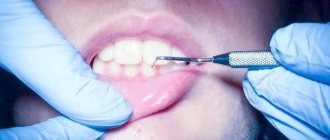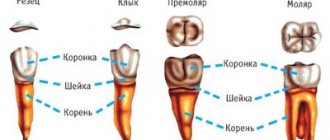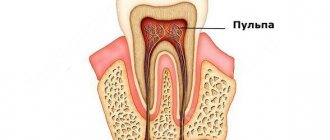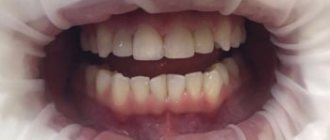Tooth nerve and need for removal
A tooth is not just a bone. In its roots there is a living pulp - blood vessels with nerve endings. This pulp is called the dental nerve; with its help, the tooth senses heat or cold. If the pulp is removed, the tooth dies, is not supplied with blood, is easily destroyed, and is less resistant to influence.
If a tooth is affected by caries, at first the destruction involves only dentin, the durable tissue of the tooth. But if caries is not treated in a timely manner, it will reach the pulp and pulpitis will begin. Then the pulp has to be removed - completely or partially, and if the pulpitis has reached periodontitis, the pulp has to be completely amputated. The nerve is also removed in case of mechanical destruction or prolonged pain.
What is a tooth nerve
Each element of the dentition consists of hard and soft tissues. The visible part is represented by dense enamel. Then comes the dentin and only then the pulp chamber, which has many root tubules and nerve endings. The number of tubules is equal to the number of roots in canines and molars. Nervous tissue plays a vital role in the formation and growth of teeth. It is responsible for nutrition, delivering the necessary nutrients to the cavity to maintain their performance. You can see what the nerve of a tooth looks like on the Internet.
With the development of carious processes, damage to the dentin and pulp chamber occurs. The dentist most often diagnoses pulpitis or periodontitis. The patient may experience severe piercing pain. The cause may be general hypothermia of the body, the development of an infection in the oral cavity, mechanical damage to the coronal part, or an advanced carious process. Most often, the patient cannot understand which element of the dental system is bothering him. He only indicates the location of the pain, and the dentist determines the cause.
Removal with arsenic
Once upon a time there was only one way to remove it, it was terribly painful, especially since you had to visit the doctor several times. At first, the doctor drilled the tooth down to the pulp with a drill, which was extremely painful. Next, arsenic was placed in the hole and it was temporarily sealed with a filling. In a couple of days, the arsenic dealt with the nerve, and the tooth hurt so much that no medicine could help. Then I had to go to the doctor again, he opened the temporary filling, removed the nerve, and cleaned the root canals. Pulp is a tenacious substance, so this process was also extremely painful.
This technology poses a certain danger, because arsenic is a poison, and the doctor, when using it, must be especially careful, and the patient must be careful: if you are late with the second visit to the doctor and leave arsenic in the tooth, it will completely destroy it, which will end deletion. Dentists stopped using arsenic and developed new techniques for removing pulp.
Modern treatment of pulpitis without the use of arsenic
Patient K. came to the clinic with complaints of severe pain in the gums in the area of the 47th tooth. The tooth was treated 3 days ago in the self-supporting department of the district clinic for chronic pulpitis.
| PHOTO 1: Visible devitalizing material at the mouth of the root canal and necrotic gums between the teeth against the background of inflamed soft tissues. | PHOTO 2: On the day of contacting our clinic, the canals were processed and sealed, the gums were treated, and a sealed temporary filling was placed (see x-ray). |
| PHOTO 3: Photo after 1 week: inflammation of the gums and soft tissues has been eliminated. | PHOTO 4: a month later, the tooth was completely restored with a ceramic inlay. |
For reference: Treatment methods for pulpitis differ in the method of anesthetizing the pulp. If devitalizing pastes (paraformaldehyde, paste with arsenic, etc.) are used to “kill the nerve,” then the methods are called devitalizing. And if the treatment takes place under anesthesia and without the use of drugs that kill the pulp, then such methods are called vital.
Everyone knows that arsenic is a poison. But it can be used for peaceful purposes. And the older generation probably remembers that arsenic was previously used by dentists to “kill the nerve.” At the same time, with arsenic in the tooth, it was under no circumstances possible to “walk” for more than the appointed time. Why was it used?
To treat pulpitis (inflammation of the “nerve”), the dental pulp must be removed and the cleaned canals of the tooth must be sealed. Since previously anesthetics were not “strong” enough, and the instruments for working in the canals were not thin and flexible enough, the dentist used arsenic to be on the safe side, so that there would be no pain in the tooth during or after the manipulation.
And even then the terms “arsenic periodontitis” and “arsenic periodontitis” arose, and scary pictures appeared in dental textbooks illustrating complications caused by the use of arsenic, such as osteomyelitis and mediastenitis. Every dental office even had an antidote - unithiol in case of an overdose of the drug.
It would seem that everything is in the past. But the incident with which I began the story happened the other day. The photograph (PHOTO 1) shows a “dead” gum.
In order to treat chronic pulpitis, the dentist at the district clinic applied a devitalizing agent (one of the most popular in our time) to the patient’s pulp of the 47th tooth, after which he installed a temporary filling. And on the third day the patient came to me complaining of pain in her gums. The material for the temporary filling turned out to be insufficiently airtight, and the toxic drug “leaked” into the gum, causing necrosis and inflammation of the surrounding tissues. The final consequences will become clear after some time and will depend on whether the toxic drug has had time to act on the jaw bone.
Currently, devitalizing agents (literally can be translated as “depriving life”) contain paraformaldehyde instead of arsenic, the toxic effect of which “poisons” the pulp and leads to its death. But if the drug turns out to be more than required, then in addition to the pulp, other tissues surrounding the tooth will be poisoned. And as a result, toxic periodontitis will develop.
The annotation for such a drug does not indicate exactly how much of the substance to use in a particular case. The manufacturers vaguely wrote: “at the discretion of the doctor.” As a doctor, I understand that every living organism is individual, so a safe amount of a product for one patient may be toxic for another. This depends on many factors: the stage of pulp inflammation, the volume of pulp tissue, the shape of the canal and the age of the patient, etc.
There is a high probability of error when using devitalizing agents.
But the main thing is: why use a potentially dangerous technique?
After all, a modern doctor has a wide arsenal of tools, tools and methods for the safe treatment of pulpitis. The choice of anesthetics allows one or another to achieve anesthesia in any patient; nickel-titanium instruments allow one to climb into curved canals and clean out the pulp under microscopic control, and rinsing the canals with antiseptics dissolves the remaining living tissue inside the canal and neutralizes microorganisms.
If a dentist uses modern techniques, why should he return to devitalizing agents?!
I admit only one reason for using a devitalizing drug - lack of time for the doctor or patient to fully treat the canals during that visit. Fortunately, these are isolated cases in practice.
The author of the article is dentist-therapist Stefanskaya V.V.
Modern pulp removal
Today, it is enough to go to the dentist once to remove the pulp. The doctor gives an anesthetic injection and calmly works with the tooth, removing the destroyed layer of dentin, extracting the pulp, treating and filling the canal. Sometimes inspection using a microscope is possible. To be on the safe side, your doctor may place a filling temporarily to make sure he has completely removed the pulp. And only if everything turns out to be in order, the final filling is installed.
Incomplete removal of the pulp is also possible, which makes sense if only the outer part of the pulp is affected by inflammation. Dead tissue is removed from the opened tooth, the outermost part of the pulp is removed, and the root remains intact. This is especially important on children's teeth, since the pulp is responsible for the formation of roots. When the pulp is not completely removed, the tooth is kept alive, and further destruction occurs more slowly.
What is arsenic used for in dentistry?
Doctors in our clinic always provide comfortable conditions for their patients. We try to make procedures less painful and faster, using various modern techniques and painkillers. But, if the situation with a bad tooth has been severely neglected, doctors have to resort to removing the nerve. This happens if the pulp is severely inflamed and treatment with other methods no longer helps. This procedure is painful and unpleasant, and to make it easier for the patient to endure it, arsenic paste is used in dentistry.
Effect of arsenic on the nerve
Arsenic has a necrotic effect on the nerve, pulp and nerve endings, that is, it essentially kills the nerve within a couple of days. The doctor applies arsenic paste to the affected area and places a temporary filling on top. After a couple of days of exposure to arsenic on the nerve, the doctor will be able to safely remove the pulp and clean the canals without discomfort for the patient. Pastes with arsenic contain anesthetic agents, so the process of nerve necrosis is also painless. The most common reasons for using arsenic are:
- Inability to use other anesthetics. There are cases when patients experience an allergic reaction or immunity to the effects of anesthetic drugs.
- Urgent treatment by the doctor on duty, when it is not possible to postpone the procedure.
- Inability to use local anesthesia due to the patient's health condition.
How dangerous is the use of arsenic?
Arsenic is indeed a strong poison, but only its derivative is used in dentistry. Thanks to the work of qualified specialists, the effect of the poison occurs exclusively on the nerve. The seal, which the doctor places on top of the applied arsenic paste, reliably protects against the poison getting into the blood or stomach. But the remedy is completely safe only if you carefully follow the instructions of your doctor.
If arsenic remains in the tooth for too long
Despite the fact that the content of toxic substances in the paste is minimal, the product must be removed from the tooth within the period specified by the doctor. The consequences of long-term use of arsenic for a patient can be very unpleasant, for example, leading to the development of diseases such as periodontitis or periostitis. Exceeding the prescribed period of use of the drug also leads to an expansion of the zone of its influence, as a result, destruction of the nerve endings of other teeth, and burns of the gums. An installed filling can, of course, last six months or a year, but this does not mean that you can postpone visiting a specialist.
Signs that the product has been in the tooth for too long:
- headache;
- nausea;
- vomit;
- heat;
- pale or bluish skin tone.
Arsenic is placed in the tooth only for a certain period, which is discussed in advance with the patient. During the next visit, the doctor removes the arsenic and installs a permanent filling.
Why does a tooth from which the nerve has been removed hurt?
Patients often complain that the tooth from which the nerve was removed continues to hurt. This is a completely natural pain, the result of intervention in the body. In a couple of days the pain will go away. It can be observed when clenching teeth, when reacting to hot and cold. To reduce discomfort, take analgesic medications.
But if, due to improper treatment, the nerve was not completely removed, the pain and inflammation will return. It is possible that the canals were poorly treated, and there may also be an allergy to the filling material. It is necessary to go to the doctor immediately, since advanced inflammation can lead to tooth loss.
The tooth from which the nerve has been removed becomes dead, but it still remains and is not lost, so if you have a toothache, immediately go to the dentist. There is nothing to be afraid of - modern treatment is painless, and after it your diseased tooth will serve you for many years to come.
Removing dental nerve using arsenic
Previously, dental nerve amputation procedures were performed using arsenic. The root canal was enlarged using a drill, then arsenic was applied to the pulp and closed with a temporary filling to “kill” the nerve. The process took 2 days and was accompanied by pain, which could not be suppressed even with the help of analgesics. After the expiration of the period, the temporary filling had to be removed, the nerve removed and the root canal cleaned. The whole procedure was very painful and lengthy, requiring visits to the doctor several times. The main disadvantage of this method is the use of arsenic, known for its strong toxic properties. Both the doctor and the patient had to be extremely careful when using this substance in treatment, because if arsenic remained in a person’s tooth for longer than the permitted period, this led to tissue destruction and even tooth loss. For these reasons, today arsenic is no longer used in medical practice, but new techniques for amputating the nerve of a tooth are being successfully introduced.
Why arsenic in dentistry
The use of arsenic is not very common now; modern treatment is carried out with arsenic-free pastes that contain an analgesic. After this paste is applied to the nerve, it should remain for several days. Throughout this period, the crown does not hurt, the nerve gradually dies, then it is also painlessly removed.
In case of severe carious destruction of the crown or in cases of pulpitis, the dentist will perform depulpation.
The dental nerve will be removed with arsenic in the following cases:
- contraindications to anesthesia, allergies to painkillers;
- characteristics of the body when existing anesthetics do not work;
- emergency dental treatment.
Arsenic cannot be used for treatment in the following cases:
- age up to 2 years;
- arsenic intolerance;
- poor access to the dental cavity;
- root disconnection;
- increased intraocular pressure;
- tooth root disease;
- systemic diseases of the genitourinary system.
Paste with or without arsenic is used only when pain relief cannot be performed. As soon as arsenic is added and a temporary filling is placed, the dental nerve begins to gradually die, causing the organ to hurt for some time, it may be painful to press on it and it reacts to temperature stimuli. After applying the arsenic paste, it should remain in the tooth for 24 to 48 hours.
If for some reason you cannot visit the dentist after the specified time to remove the nerve, complications may arise, even to the point where you will have to have the crown removed. To prevent this, you need to properly plan the treatment and do everything according to the dentist’s instructions.
How is the dental nerve removed?
The procedure is carried out in several stages:
- Radiography. It allows you to determine the vitality of the pulp, the length of the canal and the structure of the branches that need to be filled.
- Anesthesia. It can be local or general, depending on the indications and preferences of the patient. In both cases, the depulpation process is absolutely painless. General anesthesia is commonly used to treat children and people suffering from true dental phobia.
- Isolation of the tooth. To prevent bacteria from entering with saliva and at the same time make the doctor’s work easier, a latex film (cofferdam) is installed.
- Removal of the dental nerve. By excision of tissues damaged by caries, access to the pulp is provided, after which its chamber is opened and straight vertical walls are formed. The pulp is pulled out using a pulp extractor. The removal process is not very long. In modern dentistry, special files are more often used, with the help of which they expand the canal and carefully cut off the desired part of the pulp without disturbing areas sensitive to endodontic treatment.
- Installation of a temporary filling (it must be replaced after a maximum of 7 days).
- Control radiography.
- Placing a permanent filling.
How to calm the tooth nerve yourself
In some cases, it may not be possible to visit a dentist in the near future. For example, if you are far from the city, where it is impossible to find a specialized clinic. Then you can use traditional medicine recipes, use a soda-salt solution. To do this, you will need to dilute baking soda and salt in warm water and rinse your mouth. If soda and salt are not available, you can use 3 percent hydrogen peroxide, which is diluted with water in a ratio of 2:1. Then the swab is moistened in this solution and applied to the painful area of the dental system.
We looked at how to calm the dental nerve at home if you are unable to visit a dentist. Additionally, you can use herbal decoctions based on mint or chamomile. In some cases, clove essential oil is used. It is enough to drop it on a cotton swab and apply it to the painful area. It has good anti-inflammatory and antiseptic effects. However, if these funds are not at hand, and you do not know how to numb the tooth nerve that is inflamed, call the dentist on duty. It is better, of course, to immediately go to the doctor, since an independent decision can lead to the development of dangerous complications.











